Private William Wilson Morgan (7751)
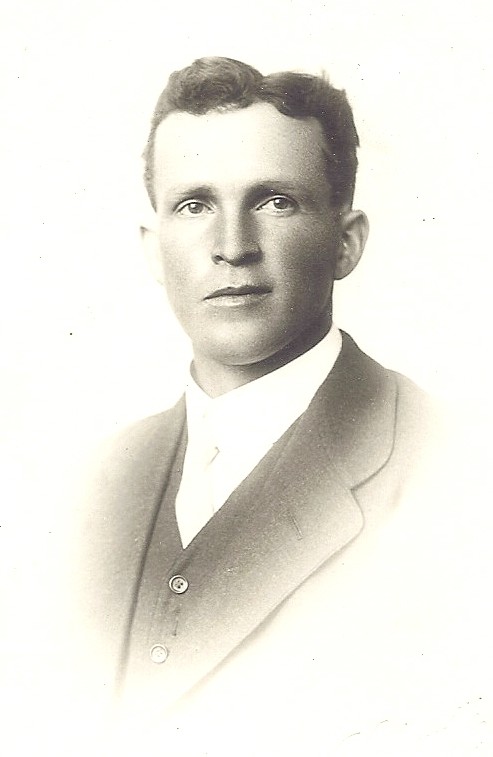
William Morgan
William Morgan, a farmer in Dowerin, came to Australia from Wales at the age of 24 and had been a clerk in the civil service before going farming. He was a friend of George Hatwell and farmed on Stacy Road off Hindmarsh Road. The property at the summit of the road was known as Morgan’s. William Morgan enlisted at Perth in April 1917 at the age of 32 years and joined the 11th Battalion, being taken on strength in France in January 1918.
Private Morgan was killed in action on 13 January 1918 near Ypres, less than two weeks after arriving in France. He has no known grave and is commemorated on the Menin Gate Memorial in Ypres. The executor of his will was George Hatwell, another farmer of Dowerin, and George wrote to Base Records in Melbourne in July of 1918 asking for a copy of William Morgan’s death certificate. William Morgan had been the best man at the wedding of George Hatwell and Mary Stewart in August 1916.
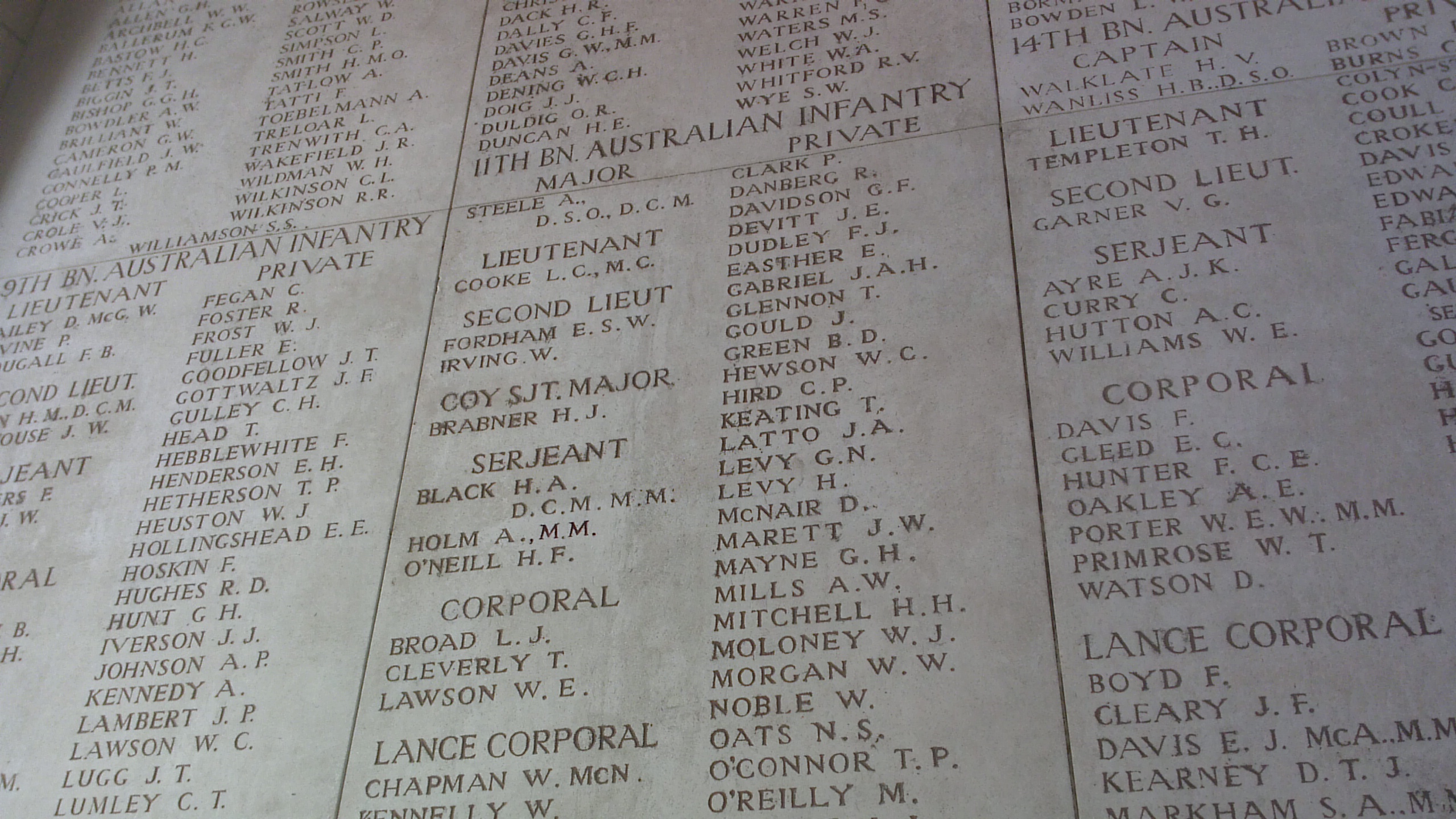
Trooper Arthur Vincent Hatwell (149)

Arthur Hatwell farmed in Dowerin with his brothers George and Joseph. Arthur enlisted in October 1914 aged 23 in the 10th Light Horse Regiment and was later transferred to the 3rd Machine Gun Squadron.
Arthur Hatwell left Alexandria for Gallipoli in mid-May 1915 and served until late August when he was transferred to the hospital on Mudros with dysentery, returning to Gallipoli on 5 September and serving until his evacuation from Mudros on 24 December 1915. In Egypt after the evacuation from Gallipoli Arthur contracted malaria and he was seriously injured in the advance on Palestine in 1917 when his horse was killed under him. His war record is short of details, but in May 1917 Arthur Hatwell was transferred from Montazah Convalescent Home to the 19th General Hospital with the following statement:
Has been very restless the last 3 days, wanders aimlessly about. Last night walked out of wrong door & fell down steps. Has tremors. Will not keep in his quarters. Feels very shaky. Wounded five times, heatstroke and dysentery.
He was invalided home, embarking at Suez for Australia on H.T. Oxfordshire and disembarking at Capetown in mid-June 1917, being admitted to No. 1 General Hospital at Wynberg to await transport to Australia. Arthur was nursed by his mother in Melbourne until his death on 12 March 1918 and he was buried in Brighton Cemetery in Melbourne.
Corporal Wesley John Cooke (7097)
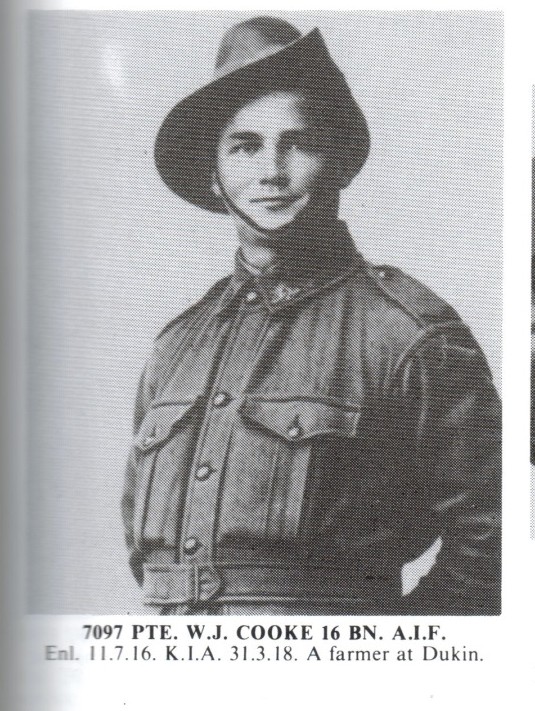
Wesley Cooke was the son of John Henry and Emily Cooke of Cowcowing and farmed there himself. In August 1916 he enlisted aged 20 in the 16th Battalion. As he was under 21, Wesley Cooke’s parents had to give their consent for him to enlist, and they both signed the letter giving of consent. After serving at Gallipoli, the battalion sailed for France in June 1916 and from then until 1918 took part in trench warfare. Wesley Cooke was taken on strength in France in June 1917. The battalion spent much of that year in Belgium advancing to the Hindenburg Line and in March and April 1918 helped to stop the German Spring offensive. For Wesley Cooke, 1917 saw him promoted to corporal in August and wounded in Belgium in October but at this time he was able to remain at duty.
Corporal Wesley Cooke was shot in the thigh on 29 March 1918 and died of his wounds 2 days later in a Canadian Stationary Hospital. He was given a full military funeral at Doullens Communal Cemetery Extension. The personal effects of Wesley Cooke were being sent back to his family in Australia on the S.S. Barunga which was lost at sea with all cargo as a result of enemy action.
Wesley Cooke had a brother, Lieutenant Leonard Charles Cooke M.C. of the 11th Battalion; both are listed on the Wyalkatchem war memorial but only Len Cooke is listed on the Dowerin memorial.
Lieutenant Matthew Allison Scouler (1078)

Matthew Scouler was the son of Robert McGregor Scouler and Isabella Allison Scouler of Blantyre, Dowerin. He had been a Junior Cadet from the time he was old enough to join and later a Senior Cadet. He won a scholarship to Scotch College at the age of 12 and went on to be a member of the shooting team and a prefect in 1911 and 1912 and secured Junior and Senior Exhibitions as the result of the Adelaide University Exams. Matthew Scouler was a much respected teacher at Scotch College in Claremont before enlisting in August 1915 aged 22. In Suez he was transferred from the 32nd Battalion to the 8th Machine Gun Company early in 1916, which was assigned to 8th Infantry Brigade. Each company was equipped with 16 Vickers Machine Guns.
Matthew Scouler was promoted to Corporal later in 1916 in France and was sent to the Machine Gun School at Bisley in England in 1917, returning to France early in 1918. In April that year he was promoted to lieutenant and killed in action.
Matthew Scouler was buried in the village churchyard at Aubigny, his brother Captain J.J.S Scouler arranged and was present at the burial service and wrote to his parents describing the grave as close to the church and beside an English Corporal. His company erected a cross on the grave and a French officer remarked at the time “Il est tombe pour l’Australie et pour La France” (He has fallen for Australia and for France). In 1919 Lieutenant Scouler was re-interred in the Adelaide British Cemetery, 2.5 miles south of Corbie.
Incidentally the Adelaide British Cemetery is where the body of the unknown Australian soldier was taken and reinserted in the Australian National War Memorial in Canberra.
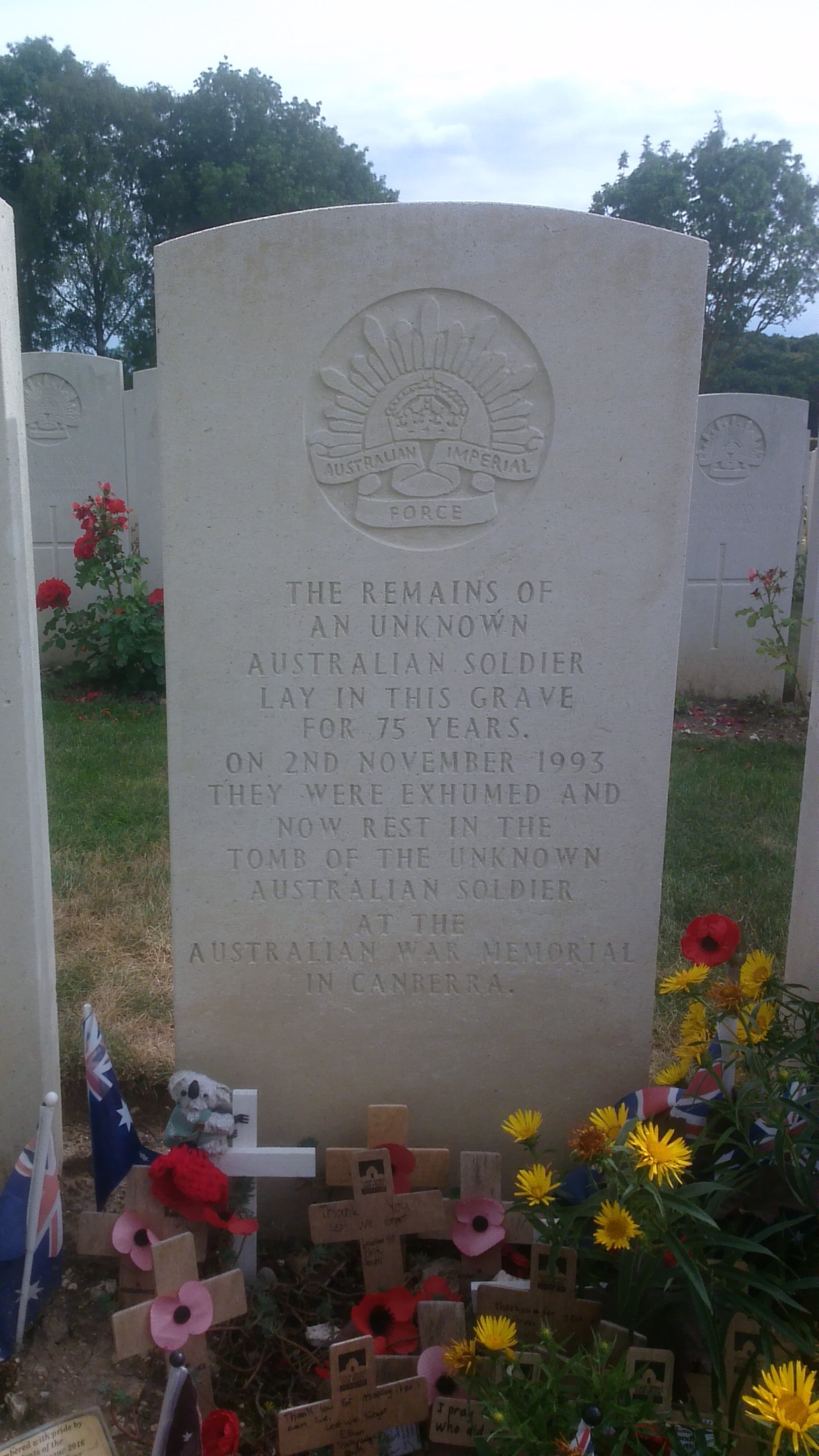
Matthew Scouler’s brother Alexander Peter Scouler (1077) served in the 5th Machine Gun Battalion and returned to Australia in December 1918; his brother Captain John James Scouler served in 1 ANZAC Cyclists Battalion and was awarded the French Croix de Guerre.
Private Leslie Anderson (4008)
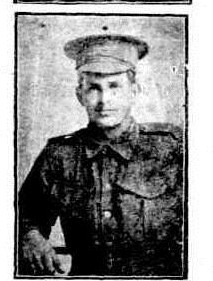
Les Anderson, a farmer, was the son of Margaret Sarah Anderson and the late Robert Anderson of Dowerin and brother of Joseph Anderson who enlisted in August 1915. The boys’ father had died in 1900. In April 1916 aged 24 Les Anderson enlisted along with his cousins Clarence and James Anderson and all three were placed in the 32nd Battalion. The three men left Fremantle together late in October 1916. Les was taken on strength with the 32nd Battalion in April 1917.
Before Les Anderson’s arrival in France the 32nd Battalion fought its first major battle at Fromelles in July 1916 where it lost close to 90 per cent of its fighting strength. In early 1917, the German Army withdrew to the Hindenburg Line allowing the British front to be advanced and the 32nd Battalion participated in the follow-up operations. The battalion subsequently missed the heavy fighting to breach the Hindenburg Line during the second battle of Bullecourt. The only large battle in 1917 in which the 32nd Battalion played a major role was Polygon Wood, fought in the Ypres sector in Belgium in September.
On night patrol in France on 14 April 1918, according to witness Pte. Andrews, Leslie Anderson was shot in the chest above the heart by one of their listening posts. He walked back to the line and was taken to the Dressing Station. Andrews reported that Les was cheerful and no-one thought he would die, but he was transferred to the 41st Casualty Clearing Station. He died of his wounds on 16 April 1918 and was buried at Namps-au-Val British Cemetery, 11 miles south west of Amiens. Mrs. Margaret Anderson requested the following words be placed on his headstone: He gave his life for his country; He fought a noble fight and Those who miss you loved you most.
Although they were all important, Les Anderson was my favourite, perhaps because he was killed by friendly fire, perhaps because he stayed cheerful regardless. Whatever the reason, it was pure chance that his was the last grave I visited in France. There is a school across the road from the cemetery; the village seems to nestle in a quiet valley as the name suggests; there were wheat fields on three sides of the cemetery. It seemed that, if he wasn’t to come home, he was in a place that would be familiar and welcoming.
Private Alfred Edward Ainsworth (7682)
Lance Corporal William Oliver Smith (3207)
Sergeant Thomas Montague Davies (2896)
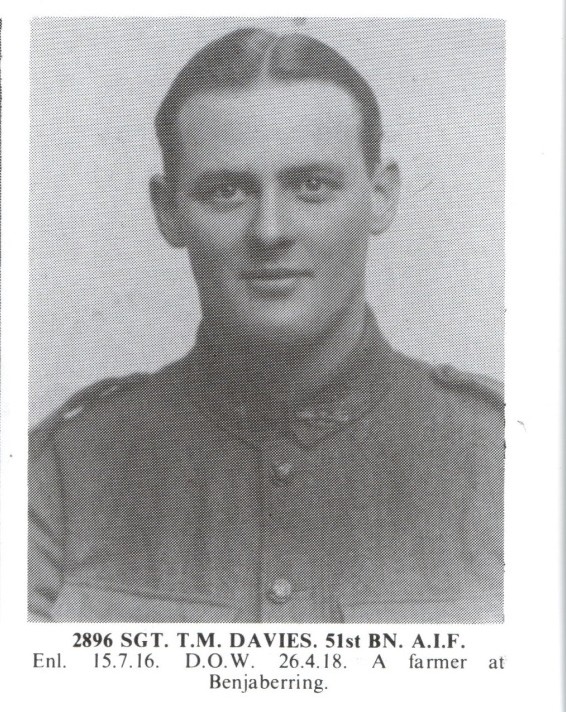
Alfred Ainsworth was the son of Alfred and Christina Ainsworth of Cowcowing and was farming before his enlistment in April 1917 aged 33; he was taken on strength with the 51st Battalion in March 1918. William Smith farmed with his brother James at Bencubbin while their eldest brother Arthur farmed east of Wyalkatchem. It is thought that James and William Smith rode to Wyalkatchem where they took the train to Perth to enlist together in August 1916. In July 1917 William Smith was taken on strength with the 51st Battalion. Monty Davies farmed with his brother W.H. Davies at Woodlands Farm in Benjaberring. He enlisted in July 1916 after 12 months with cadets in Northam, and was taken on strength with the 51st Battalion in France in May 1917. He was promoted to sergeant in April 1918.
With the collapse of Russia in October 1917, a major German offensive on the Western Front was expected in early 1918. This occurred in France in late March and the 4th Division moved to defend positions around Dernancourt on the River Ancre. The 51st Battalion assisted in the repulse of a large German attack in early April, launching a critical counter-attack late in the day. The German threat remained until late April, and in the early hours of ANZAC Day 1918 the 51st participated in the now legendary attack to dislodge the enemy from Villers-Bretonneux. In a model of a well-planned and coordinated night attack Australian troops successfully recaptured the town.
Alfred Ainsworth was killed in action at Villers-Bretonneux on 24 April 1918; he has no known grave and is commemorated on the Australian National Memorial to the missing at Villers-Bretonneux.
In mid-April William Smith was promoted to lance-corporal; he was reported missing in action and later confirmed killed in action on 24 April 1918 at Villers-Bretonneux in France and was reinterred in the Adelaide Cemetery at Villers-Bretonneux.
Monty Davies was shot in the abdomen at Villers-Bretonneux on 25 April 1918 and was admitted to the 5th Casualty Clearing Station where he died of his wound on 26 April 1918 at the age of 22 and was buried in the Crouy British Cemetery, 10 miles North West of Amiens.
Private Clarence Charles Anderson (4009)
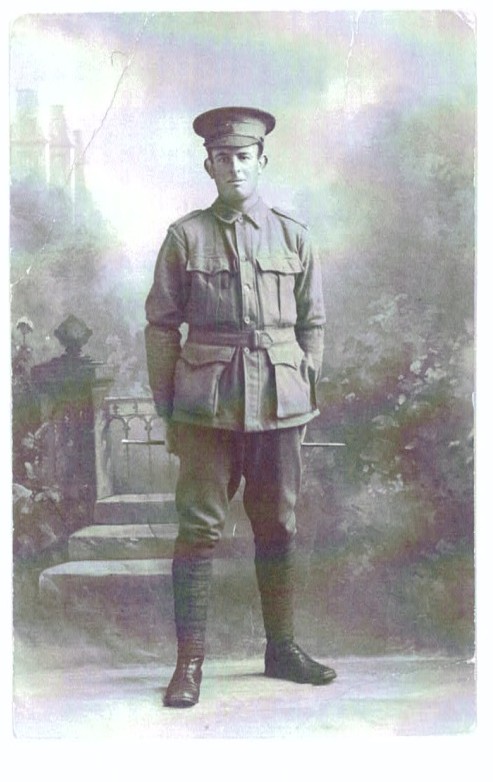
Clarence Anderson, a farmer, was the son of Charles Stephen Anderson of Dowerin. In April 1916 he enlisted aged 25 and joined the 32nd Battalion, having served 5 months in the Dowerin Light Horse. He was taken on strength in France in August 1917.
The only large battle in 1917 in which the 32nd played a major role was Polygon Wood, fought in the Ypres sector in Belgium on 26 September. Clarence Anderson was killed in action in France on 24 June 1918 and was buried that day by Sgt. A.O. Sullivan in the Vaux-Sur-Somme Communal Cemetery Extension, east of Corbie. When the Villers-Bretonneux Military Cemetery was established Clarence Anderson was re-interred there.
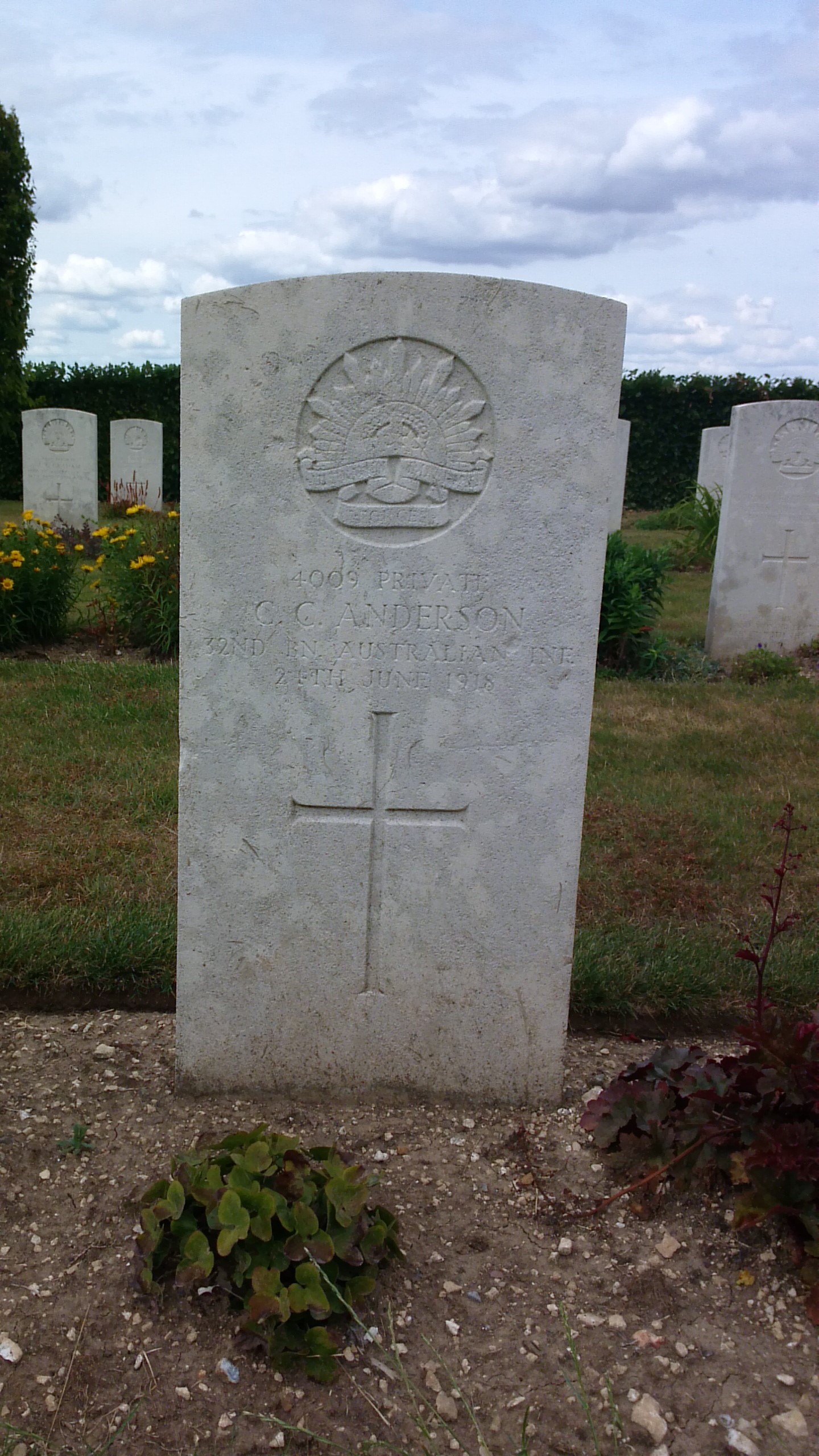
Private Leslie Harold Medbury (3270)
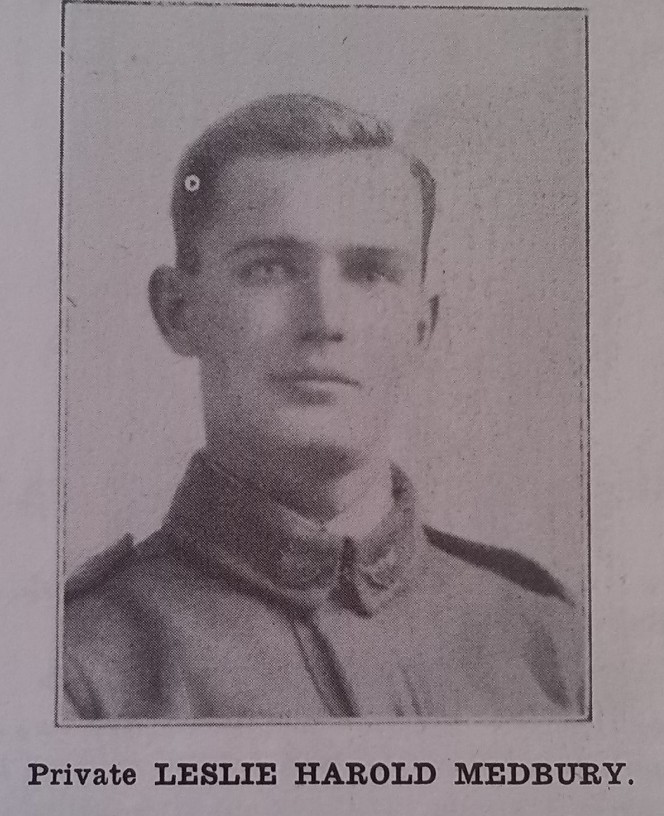
Leslie Medbury was born in Northam and educated at Northam and then on a scholarship at Perth Modern School. He was a clerk in the Commercial Bank in Dowerin and had served in army cadets when he enlisted at York at the age of 18 years and 11 months in July 1916, joining the 46th Battalion in November 1917.
The 46th rotated in and out of the front line throughout the winter of 1917-18. In the spring of 1918, the battalion played a role in turning the great German offensive by defeating attacks around Dernancourt in the first days of April. Private Medbury was wounded in action in mid-May 1918, rejoining his unit 3 days later.
Leslie Medbury was killed in action on 8 July 1918 aged 19 and buried in the Vaux Sur Somme Communal Cemetery Extension, about 2 miles from Corbie with Rev. J.C.F. Codatt of the 48th Battalion officiating; he was later reinterred in Villers-Bretonneux Military Cemetery. His name is on the Commercial Bank of Australia Roll of Honour in the In Memoriam section of the board.
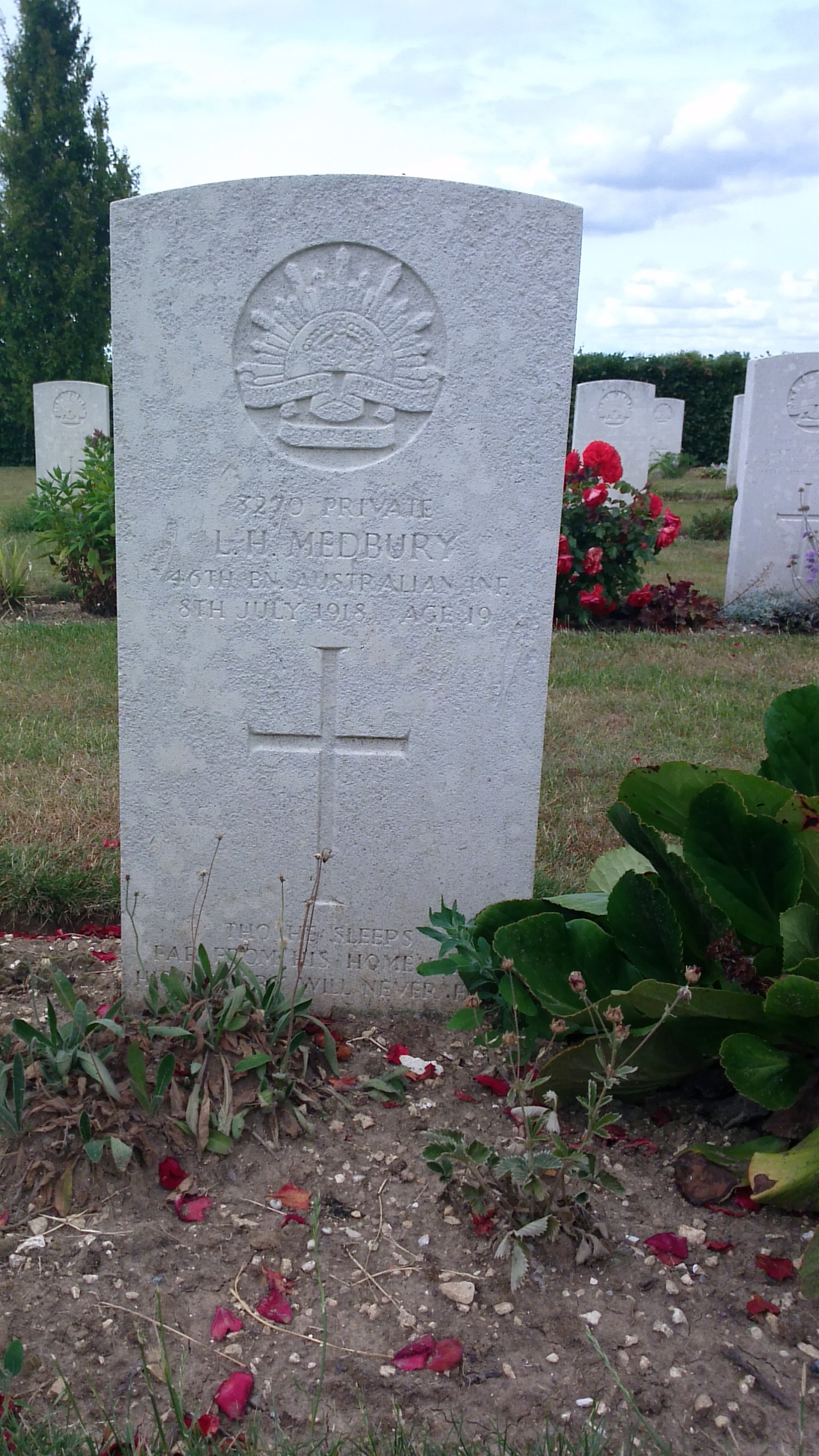
In March 1920 Leslie’s mother wrote to the army enquiring about a young West Australian soldier who was mentally affected in the war and hospitalized in England, and was at that time returned to Australia. Mrs. Medbury is asking the army to search for her son in the hospitals here as she doesn’t know where he has been taken. A reply from the army says that there is no doubt that Private L.H. Medbury was killed in action, and that photographs of his grave have been sent as well as his personal effects. In 1922 a form was sent to Leslie’s parents asking them to indicate the inscription they wished to place on his grave, and they replied that there was no grave in France containing the body of L.H. Medbury and that the Graves Commission should cross his name off any list. They did not complete the Roll of Honour details as that was only for fallen soldiers. However by November 1923 there is a letter from the army confirming words to be inscribed on Private Medbury’s grave.
Private Arthur James Hicks (7483)
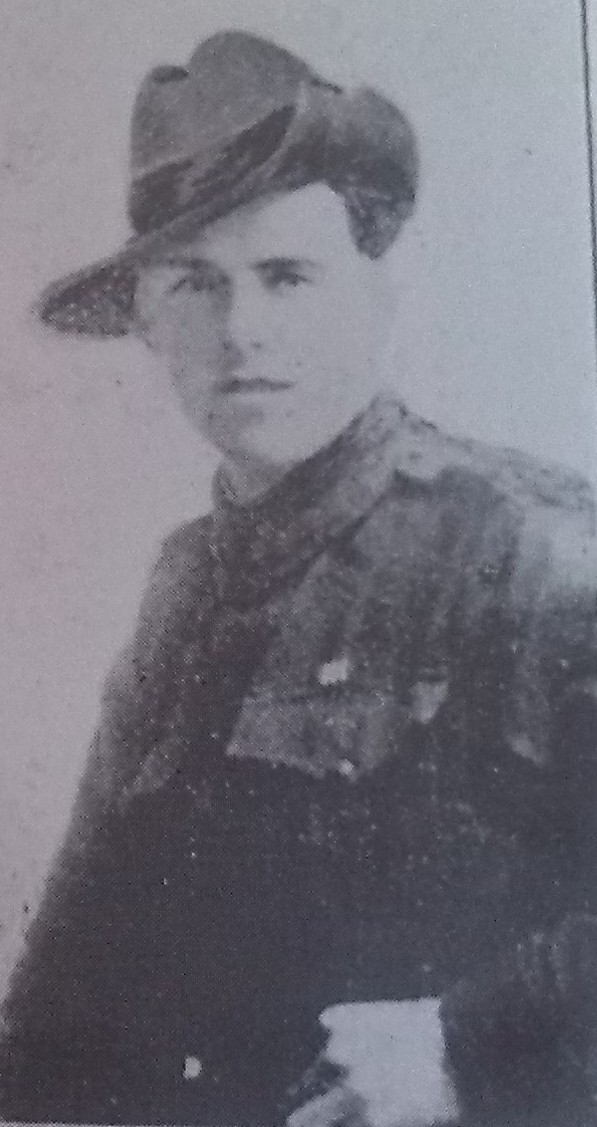
Arthur Hicks, a farmer from Minnivale, enlisted in September 1916 aged almost 31. His initial medical examination took place in Dowerin; he was taken on strength with the 11th Battalion in January 1918.
The battalion helped to stop the German spring offensive in March and April 1918, and later that year participated in the great Allied offensive launched east of Amiens on 8 August 1918. This advance by British and empire troops was the greatest success in a single day on the Western Front, one that German General Erich Ludendorff described as “the black day of the German Army in this war”
The final attack by the 11th came against the Hindenburg Outpost Line on 18 September 1918 when they launched a three-company attack around Fervaque Farm and Carpeza Copse near Villeret. Despite being severely understrength – each company had an average strength just 76 men – they advanced over 3,000 yards (2,700m) and took over 120 prisoners and large quantities of German equipment, for the loss of 18 men killed. Arthur Hicks was killed in action on 21 September 1918 and has no known grave. He is commemorated on the Australian National Memorial at Villers-Bretonneux.
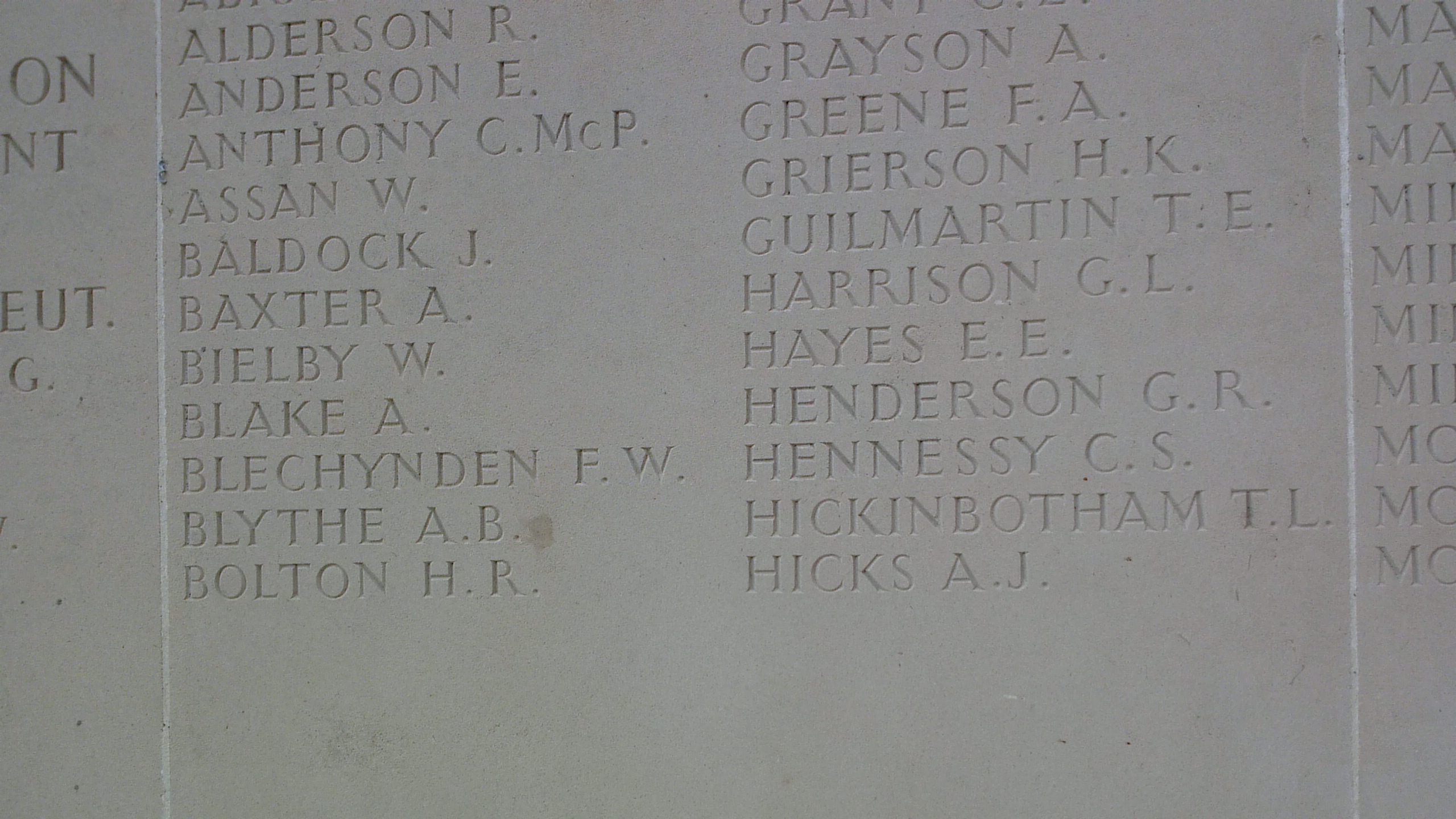
Private Alfred Drane (4049)
Alfred Drane, a labourer from Nimberrin in Baandee, enlisted in April 1916 aged 23, having previously served with the 5th Essex Territorials. He was taken on strength with the 32nd Battalion in France in March 1917.
The only large battle in 1917 in which the 32nd Battalion played a major role was Polygon Wood, fought in the Ypres sector in Belgium on 26 September. Alfred Drane was wounded by shrapnel in his right leg whilst in action on 29 July 1918 and died of his wounds the same day. In the Red Cross file there are witness recounts of his wounding. He is described as short and boyish, as a batman to an officer in No. 3 platoon. He was hit by a piece of shell about 15 minutes after “hop over”, going over the top of the trench, about 11pm or midnight. Alfred Drane was buried in Mericourt L’Abbe Communal Cemetery Extension.
Private Arthur Werndly (3229)
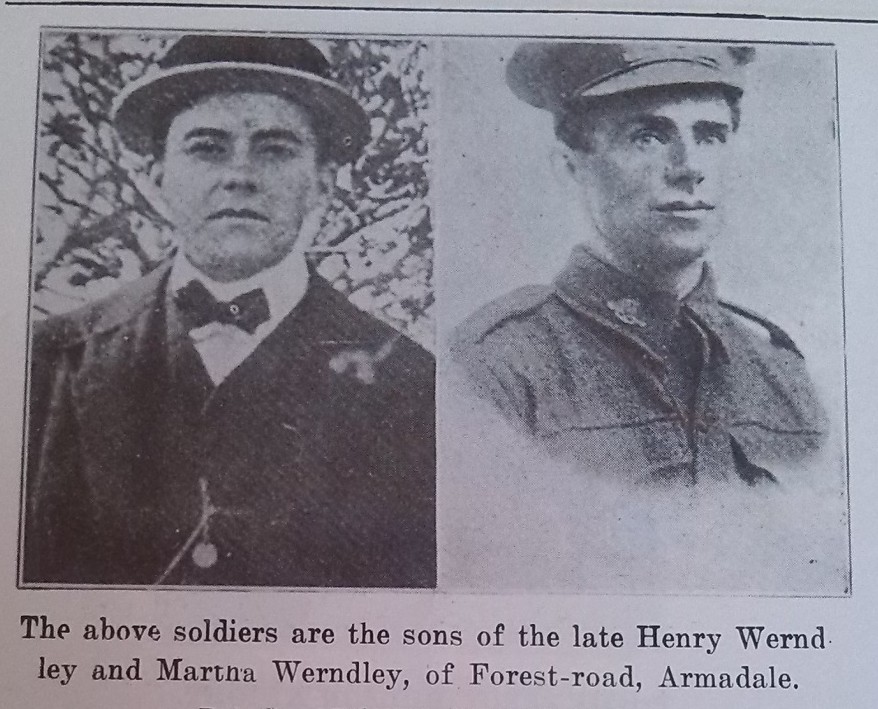
Arthur Werndly, a farmer from Dowerin, enlisted aged 32 in October 1916 and was taken on strength with the 46th Battalion in France in June 1917. The 46th Battalion had arrived in France in June 1916, destined for the Western Front and Arthur Werndley saw action at Armentieres. Later in the summer of 1917 the focus of the AIF’s operations switched to the Ypres sector in Belgium where the 46th took part in the battles of, Messines and Passchendaele. The 46th rotated in and out of the front line throughout the winter of 1917-18. In the spring of 1918, it played a role in turning the great German offensive by defeating attacks around Dernancourt in the first days of April 1918. During the Allied offensive that commenced in August, the 46th also played an active part, fighting in the battle of Amiens on 8 August and in the battle to secure the Hindenburg “outpost line” on 18 September. Arthur Werndley was killed in Jernacourt on 18 September 1918 and is buried in the Jeancourt Communal Cemetery Extension, east of Peronne.
On the Roll of Honour circular Private Werndly’s mother wrote that he went out under shell fire to bring in a wounded comrade and was killed instantly. Prior to enlisting Arthur Werndley was farming on Hindmarsh Road, south Dowerin. Arthur’s brother Frederick enlisted a few months before Arthur and he too saw action at Armentieres, Bapaume, Messines, Bullecourt and was severely wounded at Amiens in July 1918, dying of his wounds on 1st August 1918. He is buried at the British Cemetery in Amiens. After the death of her sons, Mrs. Werndly lived in Armadale.
Private Frederick Owen Werndly (4090)
It is believed that Arthur and Frederick Werndly farmed together on Hindmarsh Road in Dowerin, although Frederick does not appear on either the war memorial or the honour roll in the town. It is possible that he farmed in Armadale where his mother lived. Frederick gave his occupation as farming when he enlisted in May 1916 aged 21 and was taken on strength with the 32nd Battalion in April 1917. He died of a shrapnel wound to the head received in action on 2 August 1918 and was buried in the Pernois British Cemetery north of Amiens. Among his returned effects were 10 religious medallions.
Sergeant John William Harris MM (5104)
John Harris, a grocer from Drummond Street in Carlton, Melbourne, was the son of John and Mary Jane Harris, storekeepers of Minnivale, and the brother of Arthur Harris who was also killed on active duty in France. John Harris was the husband of Ursula Harris and, while they had a connection with Minnivale through his parents, it is unclear whether either John or Ursula ever lived in the Dowerin district. He enlisted in January 1916 in Melbourne and was placed in the 4th Pioneer Battalion, embarking Australia in April 1916. In May 1916 John Harris was promoted to the rank of lance corporal, a year later to corporal and in February 1918 John Harris was promoted to the rank of sergeant.
John Harris’s military career was mixed; he was in trouble for attempting to steal 4 drinking glasses while on active service in August 1917; he was awarded the Military Medal on 23 July 1918. The citation for his Military Medal reads that:
on the night of 8 July 1918 at Vaire Wood, Sergeant Harris was in charge of a working party in an exposed position. On the opening of a sudden and heavy enemy barrage, several of his men became casualties and Sergeant Harris showed conspicuous bravery and complete disregard of personal safety in getting the wounded under cover, and by his example keeping his men steady, thereby minimizing casualties and enabling the work to be completed.
Between March and June 1918 John Harris was detached for duty with the 184th Tunnelling Co. On 6 August 1918 Sergeant Harris died of his wounds and was buried at Vaire Communal Cemetery, 1 mile east of Corbie in France, outside the cemetery. He was reinterred in the Adelaide Military Cemetery at Villers Bretonneux.
Private Edwin Otis Moseley (8007)

Edwin Moseley was born in Perth the eldest of 3 sons of Francis Arnold and Lucy Darling Moseley who lived in Cottesloe. Francis Moseley was the Registrar of the Supreme Court. In September 1917 when he enlisted at Northam Moseley, who was aged 36 and married to Edith Isabel Moseley, gave his occupation as bank manager. His address on enlistment is given as Kellerberrin, but that is crossed out and changed to Cottesloe Beach. Later Mrs. Edith Moseley was living at a house called Thorn Lea at Cottesloe Beach. Moseley was manager of the Dowerin branch of the National Bank between 1911 and 1913, then transferred to the Kellerberrin branch of the Bank in November 1913 before enlisting in 1917.
Moseley joined the 16 Battalion and after some time in hospital in England was taken on strength in France in June 1918.
The battalion participated in the great allied offensive of 1918, fighting near Amiens on 8 August 1918. This advance by British and empire troops was the greatest success in a single day on the Western Front, one that German General Erich Ludendorff described as ‘..the black day of the German Army in this war’. Edwin Moseley was killed in action on 8 August 1918, and was buried in Heath Cemetery in Harbonnieres, leaving a widow and one child. Edwin Moseley is also listed on the Wyalkatchem war memorial and the Kellerberrin war memorial. In Cottesloe at St. Columba’s Presbyterian Church, where Edwin’s father laid the foundation stone, there is a plaque to Edwin Otis Moseley under the stained glass window dedicated to his father. The Great War honour roll that hangs in the church lists the three Moseley brothers, Henry Doyle Moseley, Francis Arnold Moseley and Edwin Otis Moseley.
Lance Sergeant William John Hamilton MM (931)
William Hamilton, a farm labourer of Goomalling, enlisted in August 1914 aged 24, having served with the Royal Irish Rifles and discharged as medically unfit because of an injured shoulder, and joined the 12th Infantry Battalion. The 12th was part of the 3rd Brigade and was among the first ashore at around 4:30am on 25 April 1915 and was heavily involved in establishing and defending the front line of the ANZAC position. Part of the battalion took part in the attack on Lone Pine and the 12th served at Gallipoli until the evacuation in December although William Hamilton was evacuated early with enteric fever.
William Hamilton was promoted in July and August 1917. He was awarded the Military Medal for his conduct during the battle for Polygon Wood:
During the attack on Polygon Wood, east of Hooge, on the night of 20th/21st September 1917, Corporal Hamilton along with Private Thomas Burgess were instrumental in the capture of a strong post on the left flank. With great tact and fearlessness they moved round to its rear and gallantly rushed it, causing its garrison of some dozen Germans to surrender.
After being hospitalized for another bout of bronchitis and despite being still unwell, William Hamilton returned to France in July 1918. On 17 August 1918 he was wounded in action, suffering shrapnel wounds causing a compound fracture of the skull, and right arm. He was taken to the 2nd Canadian General Hospital but never regained consciousness and died of his wounds on 19 August 1918. William Hamilton was buried at the Mont Huon Cemetery in Le Tréport, on the cliffs overlooking the English Channel.
Private Maitland Hazel Maitland (2372)

Mait Maitland farmed at Korrelocking with his brother James Hazel Maitland and enlisted in May 1916 aged 21, joining the 43rd Battalion and being taken on strength in France in April 1917. The 43rd Battalion spent 1917 bogged in bloody trench warfare in Flanders. In June it took part in the battle of Messines, a successful assault on a strongly held strategic position that the Germans had held since late 1914. The attack was preceded by the detonation of 19 mines under the German front line and British, Australian and New Zealand infantry advanced behind a carefully coordinated artillery bombardment. In October the 43rd was involved in the Third Battle of Ypres, a major offensive planned to break though the strongly fortified German defences enclosing the Ypres salient with the intention of sweeping through to the German submarine bases on the Belgian coast. Frequent rain and the destruction of the drainage system by bombardment meant this was a series of limited and costly offensives in difficult water-logged conditions, including the battles of Menin Road, Polygon Wood, Broodseinde, Poelcappelle and Passchendaele. Despite heavy losses, no breakthrough was achieved.
The 43rd Battalion spent much of 1918 fighting in the Somme valley and in April helped stop the German Spring offensive at Villers-Bretonneux. Private Maitland was wounded in May 1918 but returned to active service. In July the battalion was part of General Monash’s attack at Hamel where British Mark V tanks and very accurate artillery barrages meant the Australians, with American troops, quickly overran the German positions. In August and September the battalion helped drive the Germans back to the Hindenburg Line and Mait Maitland was wounded again on 22 August 1918, this time in the abdomen. He died of his wounds on that day. Maitland’s file indicates that he was buried at Sailly-Laurette Military Cemetery, then reinterred at Vaux-sur-Somme Cemetery and finally reinterred in Villers-Bretonneux Military Cemetery.
Lance Corporal Norman Henry Speakman (2626)
Norman Speakman, a farmer from Badgerin north of Dowerin, enlisted in July 1916 aged 26 and joined the 43rd Battalion, shortly after Mait Maitland. In England trained at the School of Musketry at Tidworth including the use of the Lewis Gun; he was promoted and proceeded to France in November 1917.
The battalion spent much of 1918 fighting in the Somme valley. On 30 March 1918 Norman Speakman was wounded in action in the jaw and returned to England for treatment, rejoining the unit in July around the time of General Monash’s attack at Hamel. In August and September the battalion helped drive the Germans back to the Hindenburg Line. The 43rd joined the advance that followed the 2nd Division’s victory at Mont St Quentin and it was during this operation that Temporary Corporal Lawrence Weathers earned the battalion’s only Victoria Cross.
Norman Speakman was wounded again in action on 1 September 1918, this time with a gunshot wound to the spine, at which point he was invalided to England and admitted to a military hospital with paraplegia; he returned to Australia in 1919 where he died from this wound on 17 March 1920 in hospital in No 8 Australian General Hospital and is buried in Fremantle Cemetery.
Private Frederick James Phillips (2154)
Frederick Phillips was a 26 year old carpenter from Portarlington, Victoria and brother to William Charles Phillips who farmed in Dowerin when Frederick enlisted in March 1915 and joined the 2 Pioneer Battalion. He was wounded in the leg in action in France on 17 August 1917 and again in the head on 20 April 1918, suffering also from concussion. He returned to Australia in June 1918 with pulmonary tuberculosis. He died on 9 November 1918 in the sanatorium at Wooroloo, called the Wooroloo Military Hospital, and is buried in Wooroloo Cemetery in a Commonwealth War Grave. Wooroloo Hospital was established by the government of Western Australia as a sanatorium for the treatment of pulmonary tuberculosis with the first building erected in 1914 and an official opening in May 1915. In February 1917 part of the hospital became No. 22 Army General Hospital and until the end of the war soldiers with tuberculosis were treated there.
Sergeant Edmund Youlden Taylor (8006)
Edmund Taylor was a famer in Booralaming, a Mercantile Commission Agent in Dowerin between 1912 and 1916 and the Secretary of the Dowerin Road Board in 1913 and 1914. After serving in the 25th Light Horse Edmund Taylor enlisted at Dowerin in March 1916 at the age of 45 and joined the 10th Light Horse Regiment. In September 1916 Edmund Taylor was on parade at Claremont Camp when his horse reared up and threw him, he struck his right shoulder against a post as he fell and he was taken to the No 8 Australian General Hospital in Fremantle where he remained for 3 months, having sustained a fractured scapula or clavicle. He was discharged as permanently unfit on 19 February 1917, having limitation of movement and stiffness in his arm and shoulder and considered to be not suitable for active service.
After briefly returning to Dowerin, Edmund Taylor reenlisted in June 1917 at Perth and was placed in the 3rd Tunnelling Company. He was sent to Victoria for training and promoted to corporal in July 1917 and to sergeant in November that year. He was taken on strength with the 3rd Tunnelling Company in February 1918. Edmund Taylor returned to Australia in 1919.
After returning to Australia Edmund Taylor resided briefly in Dowerin but then worked as an Immigration Agent for the Western Australian government in London. He became unhappy with the treatment of migrants and returned to Western Australia and took up a Soldier Settlement farm at Yandanooka Estate at Mingenew and in March 1926 he was appointed a Justice of the Peace for the Victoria Magisterial District, serving on cases that came before the Mingenew Police Court, and serving as Secretary of the Gala Day in Yandanooka in 1930. Edmund Taylor was also a member of the Yandanooka Farmers’ Association and the Yandanooka Sub-Branch of the Returned Soldiers’ League among other organizations. He resided and farmed in Yandanooka until his death at the age of 80 in 1950. Edmund Taylor died a bachelor and is buried in Mingenew Cemetery. He left bequests to schools and organizations in the Mingenew district.


























